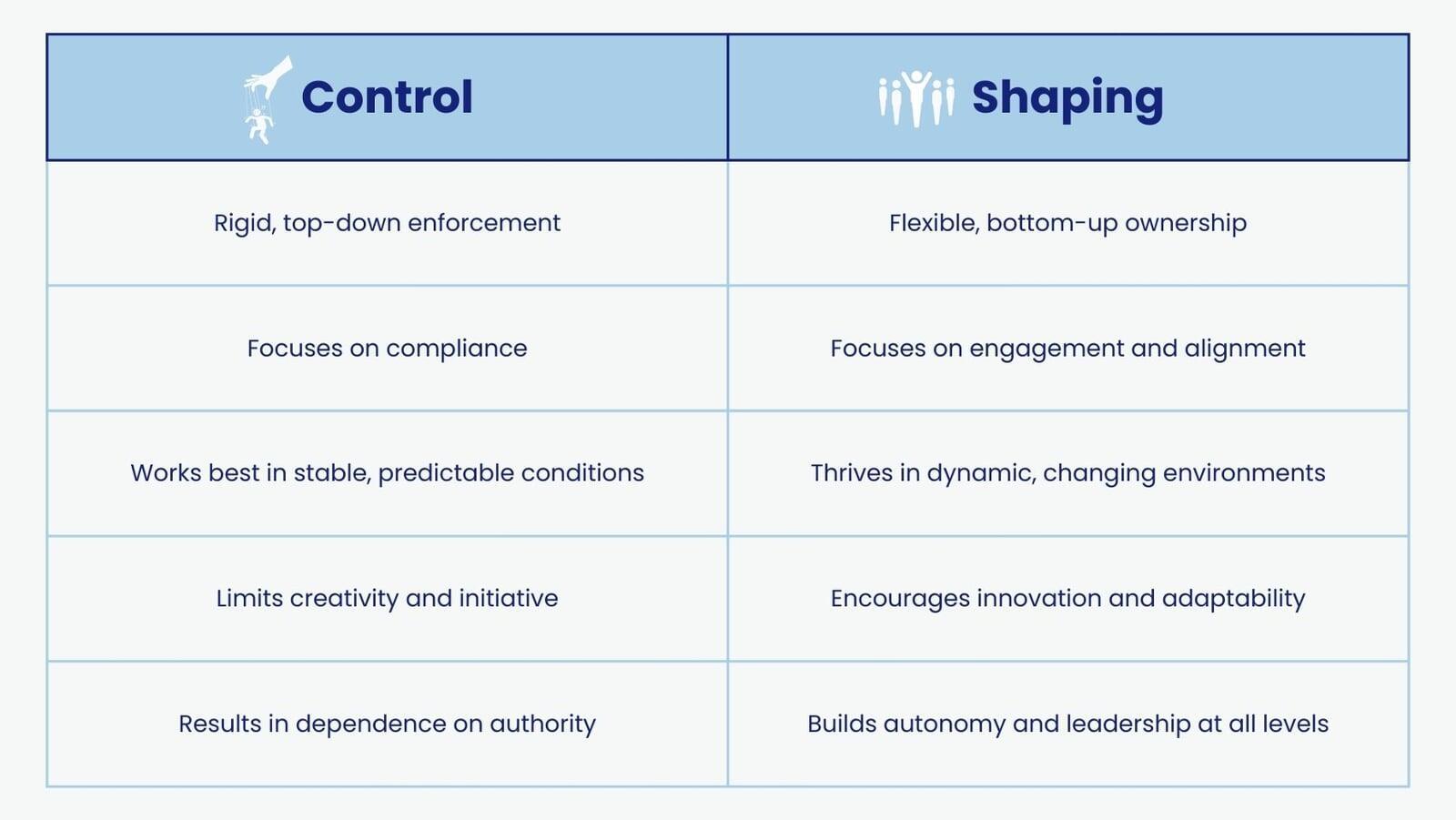
The Paradox of Control
Leaders often default to control when they want predictable results. Control is structured, rigid, and directive. It dictates outcomes, enforces compliance, and leaves little room for deviation. While this approach is sometimes necessary—such as in crisis situations or industries requiring strict adherence to safety protocols—it comes with a cost. Control tends to stifle creativity, discourage ownership, and generate unintended consequences.
Consider the leader who meticulously dictates every aspect of their team’s work. The team may execute flawlessly in the short term, but over time, they stop thinking for themselves, waiting instead for instructions. They become reactive rather than proactive. The result? A stagnant, compliance-driven environment where innovation is rare, morale is low, and adaptability is compromised.
Now, contrast this with shaping and influence, which are subtler but more powerful forces for leadership and organizational effectiveness.
Influence and Guidance: A Dynamic Approach
I refer to this as Shaping it's about guiding rather than dictating, inspiring rather than demanding. It involves setting a vision, creating an environment where people can exercise control over their work, and allowing adaptability to emerge naturally. Shaping is akin to how the banks of a river guide the water. The banks provide structure, but they also shift over time as the river carves its path. The relationship is dynamic—each influences the other.
When a leader shapes rather than controls, they hand ownership to the people closest to the work. Instead of rigid top-down directives, the team is given principles and values to operate within, allowing for greater alignment between vision and execution. This approach encourages innovation, engagement, and the ability to adapt as circumstances change.
Ethical Alignment: A Parallel to Leadership
This contrast between control and shaping mirrors the difference between rigid, external ethical codes and value-driven moral frameworks. A rigid ethical doctrine dictates what is right and wrong in absolute terms, leaving no room for context. A values-based ethical stance, however, provides a foundation from which individuals make decisions that align with their deeper principles while also allowing for nuance.
In leadership, this distinction matters. Leaders who enforce control through strict policies often struggle to adapt when circumstances shift. Those who lead through influence, shaping, and shared values create an ecosystem of trust and adaptability, where decisions are made not out of fear of punishment but because they align with a larger purpose.
The Relationship Between Control and Shaping
Control and shaping operate in fundamentally different ways:

Leadership in Action: How to Shift from Control to Shaping
If you want to lead through shaping rather than control, consider these shifts in your approach:
1/ Define Principles, Not Just Rules:
Instead of dictating every action, define guiding principles. For example, rather than setting strict work hours, emphasize the importance of outcomes and accountability.
2/ Invite Participation in Decision-Making
Engage your team in shaping policies and strategies. When people have a say in the process, they are more likely to take ownership of the results.
3/ Encourage Autonomy Within a Framework
Like the banks of a river, provide enough structure to guide efforts while allowing for evolution and change.
4/ Cultivate a Learning Culture
Control often comes from a fear of mistakes. Instead, foster an environment where mistakes are seen as learning opportunities.
5/ Model Adaptive Leadership
Be willing to evolve as conditions change. Show your team that flexibility and responsiveness are valued over rigid adherence to outdated plans.
6/ Use Influence to Shape Behavior Over Time
Control demands immediate obedience, but influence works gradually, fostering lasting commitment and intrinsic motivation.
Leading Beyond the Workplace
This approach applies not only in business but also in personal leadership—whether in parenting, relationships, or community involvement. Just as children develop better decision-making skills when parents guide rather than dictate, employees thrive when given the space to grow within a structured but adaptable environment.
Instead of trying to control every aspect of your environment, consider how you can shape it in a way that allows for natural evolution while still holding a clear and steady direction. Control imposes. Shaping aligns. Control restricts. Shaping liberates.
The choice between control and shaping isn’t just a leadership decision—it’s a philosophy that influences the very nature of progress, creativity, and human potential.

